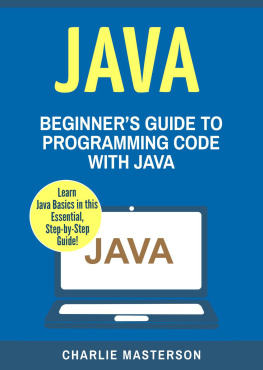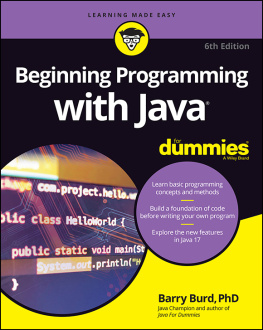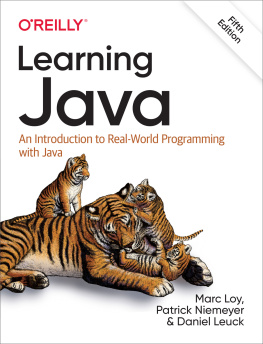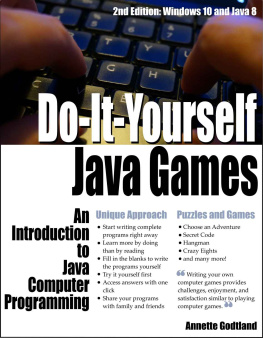About This E-Book
EPUB is an open, industry-standard format for e-books. However, support for EPUB and its many features varies across reading devices and applications. Use your device or app settings to customize the presentation to your liking. Settings that you can customize often include font, font size, single or double column, landscape or portrait mode, and figures that you can click or tap to enlarge. For additional information about the settings and features on your reading device or app, visit the device manufacturers Web site.
Many titles include programming code or configuration examples. To optimize the presentation of these elements, view the e-book in single-column, landscape mode and adjust the font size to the smallest setting. In addition to presenting code and configurations in the reflowable text format, we have included images of the code that mimic the presentation found in the print book; therefore, where the reflowable format may compromise the presentation of the code listing, you will see a Click here to view code image link. Click the link to view the print-fidelity code image. To return to the previous page viewed, click the Back button on your device or app.
Introduction to Programming in Java
An Interdisciplinary Approach
SECOND EDITION
Robert Sedgewick
Kevin Wayne
Princeton University

Boston Columbus Indianapolis New York San Francisco Amsterdam Cape Town
Dubai London Madrid Milan Munich Paris Montreal Toronto Delhi Mexico City
So Paulo Sydney Hong Kong Seoul Singapore Taipei Tokyo
Many of the designations used by manufacturers and sellers to distinguish their products are claimed as trademarks. Where those designations appear in this book, and the publisher was aware of a trademark claim, the designations have been printed with initial capital letters or in all capitals.
The authors and publisher have taken care in the preparation of this book, but make no expressed or implied warranty of any kind and assume no responsibility for errors or omissions. No liability is assumed for incidental or consequential damages in connection with or arising out of the use of the information or programs contained herein.
For information about buying this title in bulk quantities, or for special sales opportunities (which may include electronic versions; custom cover designs; and content particular to your business, training goals, marketing focus, or branding interests), please contact our corporate sales department at or (800) 382-3419.
For government sales inquiries, please contact .
For questions about sales outside the United States, please contact .
Visit us on the Web: informit.com/aw
Library of Congress Control Number: 2017934241
Copyright 2017 Pearson Education, Inc.
All rights reserved. Printed in the United States of America. This publication is protected by copyright, and permission must be obtained from the publisher prior to any prohibited reproduction, storage in a retrieval system, or transmission in any form or by any means, electronic, mechanical, photocopying, recording, or likewise. For information regarding permissions, request forms, and the appropriate contacts within the Pearson Education Global Rights & Permissions Department, please visit www.pearsoned.com/permissions/.
ISBN-13: 978-0-672-33784-0
ISBN-10: 0-672-33784-3
1 17
To Adam, Andrew, Brett, Robbie,
Henry, Iona, Peter, Rose,
and especially Linda
To Jackie, Alex, and Michael
Programs
Preface
The basis for education in the last millennium was reading, writing, and arithmetic; now it is reading, writing, and computing. Learning to program is an essential part of the education of every student in the sciences and engineering. Beyond direct applications, it is the first step in understanding the nature of computer sciences undeniable impact on the modern world. This book aims to teach programming to those who need or want to learn it, in a scientific context.
Our primary goal is to empower students by supplying the experience and basic tools necessary to use computation effectively. Our approach is to teach students that composing a program is a natural, satisfying, and creative experience. We progressively introduce essential concepts, embrace classic applications from applied mathematics and the sciences to illustrate the concepts, and provide opportunities for students to write programs to solve engaging problems.
We use the Java programming language for all of the programs in this bookwe refer to Java after programming in the title to emphasize the idea that the book is about fundamental concepts in programming, not Java per se. This book teaches basic skills for computational problem solving that are applicable in many modern computing environments, and is a self-contained treatment intended for people with no previous experience in programming.
This book is an interdisciplinary approach to the traditional CS1 curriculum, in that we highlight the role of computing in other disciplines, from materials science to genomics to astrophysics to network systems. This approach emphasizes for students the essential idea that mathematics, science, engineering, and computing are intertwined in the modern world. While it is a CS1 textbook designed for any first-year college student, the book also can be used for self-study or as a supplement in a course that integrates programming with another field.
Coverage
The book is organized around four stages of learning to program: basic elements, functions, object-oriented programming, and algorithms (with data structures). We provide the basic information readers need to build confidence in their ability to compose programs at each level before moving to the next level. An essential feature of our approach is the use of example programs that solve intriguing problems, supported with exercises ranging from self-study drills to challenging problems that call for creative solutions.
Basic elements include variables, assignment statements, built-in types of data, flow of control, arrays, and input/output, including graphics and sound.
Functions and modules are the students first exposure to modular programming. We build upon familiarity with mathematical functions to introduce Java functions, and then consider the implications of programming with functions, including libraries of functions and recursion. We stress the fundamental idea of dividing a program into components that can be independently debugged, maintained, and reused.
Object-oriented programming is our introduction to data abstraction. We emphasize the concepts of a data type and their implementation using Javas class mechanism. We teach students how to use, create, and design data types. Modularity, encapsulation, and other modern programming paradigms are the central concepts of this stage.
Algorithms and data structures combine these modern programming paradigms with classic methods of organizing and processing data that remain effective for modern applications. We provide an introduction to classical algorithms for sorting and searching as well as fundamental data structures and their application, emphasizing the use of the scientific method to understand performance characteristics of implementations.
Applications in science and engineering are a key feature of the text. We motivate each programming concept that we address by examining its impact on specific applications. We draw examples from applied mathematics, the physical and biological sciences, and computer science itself, and include simulation of physical systems, numerical methods, data visualization, sound synthesis, image processing, financial simulation, and information technology. Specific examples include a treatment in the first chapter of Markov chains for web page ranks and case studies that address the percolation problem,








